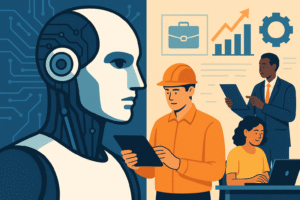What Is AI for SMEs?
AI for SMEs means implementing cost-effective, scalable artificial intelligence solutions tailored for small and medium businesses. Think of AI business strategies as a flexible toolkit—from automating repetitive tasks to driving powerful insights from your business data. These approaches help SMEs streamline operations, cut costs, boost customer engagement, and unlock expansion opportunities.
Key Benefits of AI in SMEs
- Time savings: Automate routine, repetitive processes.
- Improved accuracy: Reduce errors in inventory, finance, and reporting.
- Personalized marketing: Offer hyper-targeted interactions to your customers.
- Data-driven decisions: Leverage analytics and predictive tools for growth.
- Scalable innovation: Adapt tools as your business grows.
Laying the Groundwork: The Best AI Business Strategies for SMEs
To kickstart your journey, let’s break down proven AI business strategies that SMEs are adopting in 2025.
1. Align AI with Your Business Goals
Start by mapping AI initiatives directly to your specific business objectives. Founders and managers should ask:
- What repetitive or manual tasks eat up valuable time?
- Which operations would benefit from smarter automation or predictive insights?
Successful SMEs use AI to target areas with the greatest measurable impact, such as customer support, marketing, and operations.
2. Identify High-Impact Use Cases for AI
Not all problems need an AI solution. Focus efforts on workflows where automation or analytics can create substantial savings or revenue growth:
- Customer Service Chatbots: Automate FAQs and support, freeing staff for complex issues.
- AI Marketing Automation: Personalize campaigns and manage social media at scale.
- Inventory Optimization: Use AI-driven forecasting for just-in-time stock management in retail and logistics.
- Financial Automation: Streamline bookkeeping and manage expenses with AI-enabled platforms.
3. Choose the Right AI Tools for SMEs
There are powerful, affordable tools tailored to various business needs. Here are a few of the best for 2025:
Overcoming the Top Challenges of AI Business Strategies
Adopting AI for SMEs isn’t without obstacles. Research shows that more than half of SME leaders don’t fully understand how AI fits their business. The main challenges include knowledge gaps, resistance to change, and lack of in-house expertise.
How to Overcome Barriers:
- Education & Training: Invest in workshops and online courses for your teams. Free and freemium tools like Coursera and HubSpot Academy offer AI basics for business.
- Phased Implementation: Start with small experiments—like introducing chatbots or automating email campaigns—before rolling out complex solutions.
- Workforce Empowerment: Make sure your staff is comfortable using new tools and understands their benefits. Celebrate small wins to drive adoption and improve morale.
- Expert Partnerships: Consider managed service providers or AI consultants to supplement skill shortages, especially for advanced integration.
Real-World AI for SMEs: Case Studies Across Industries
Case Study #1: Retailer Saves 10+ Hours/Week with Inventory AI
A local brick-and-mortar sporting goods store implemented an AI-powered demand forecasting tool to optimize inventory. By analyzing historical sales data and market trends, the system recommended reorder points and helped eliminate stockouts. The result? A 40% reduction in manual stock checks and a 20% decrease in lost sales due to out-of-stock items.
- Tools Used: InventoryAI, Zapier automated workflows
- Tip: Start with a free trial, integrate with existing POS, and review model suggestions weekly.
Case Study #2: B2B Marketing Agency Doubles Outreach with AI Automation
A boutique marketing agency specializing in SME clients integrated Copy.ai for rapid content creation and Surfer SEO to optimize blog content for client websites.
By automating newsletter drafts and on-page SEO, the agency produced twice the amount of content monthly, leading to a 35% increase in lead generation.
- Tools Used: Copy.ai, Surfer SEO, HubSpot CRM
- Workflow Tip: Use AI content suggestions but always review with a human touch to ensure brand consistency and relevance.
Boost Productivity: How AI for SMEs Saves Time
Smart time management is non-negotiable for growing businesses. Here’s how AI helps SMEs save hours every week:
- Automated Scheduling: Tools like Calendly with AI integration help book meetings while avoiding conflicts.
- AI-Powered Accounting: Platforms such as QuickBooks Online suggest categorizations and proactively flag suspicious transactions.
- Dynamic Email Responses: Google Workspace’s AI-based email drafting features enable faster, more consistent communications.
AI for SMEs in Different Sectors: Use Cases That Deliver Results
1 AI in Retail
- Dynamic pricing engines optimize product rates in real time, boosting profits.
- Personalized recommendations increase conversion rates in e-commerce stores.
2 AI in Services
- Auto-scheduling bots streamline appointment bookings for salons and clinics.
- Voice-to-text transcription tools automate documentation in legal or consultancy settings.
Overcoming Challenges in AI Adoption
While the promise of AI for SMEs is immense, there can be perceived challenges. Many small business owners worry about the cost, complexity, or the need for specialized technical skills. However, these concerns are often surmountable.
- Start Small: Don’t try to overhaul your entire business with AI overnight. Identify one or two pain points where AI can offer a clear and measurable solution. Begin with a pilot project, learn from the experience, and then gradually expand your AI adoption.
- Leverage Cloud-Based Solutions: Most modern AI tools are cloud-based SaaS (Software as a Service) platforms, meaning you don’t need significant upfront investment in hardware or complex IT infrastructure. These solutions are often subscription-based and scalable.
- Focus on Training: Empower your team with knowledge. Provide training on how to use new AI tools and help them understand how AI can augment their work, not replace it. Emphasize the time-saving and efficiency benefits.
- Data Quality is Key: AI thrives on data. Ensure your business has clean, organized, and accessible data. This might require some initial effort, but it’s a foundational step for effective AI implementation.
The Future is AI-Powered: Your Next Steps
The integration of AI for SMEs is not a fleeting trend; it’s a fundamental shift in how businesses operate and compete. By strategically embracing AI, small and medium enterprises can unlock unprecedented levels of efficiency, innovation, and customer satisfaction. It’s about working smarter, not just harder, and leveraging technology to empower your human talent.
To truly capitalize on the power of AI for SMEs, start by assessing your current business processes. Where are the bottlenecks? Where do repetitive tasks consume valuable time? These are often the ideal starting points for AI implementation. Explore the user-friendly tools available and don’t hesitate to experiment. The future is bright for businesses willing to embrace the transformative power of AI.
3 AI in Manufacturing
- Digital twins simulate production shifts, identifying bottlenecks and recommending workflow improvements.
- Predictive maintenance sensors prevent costly machine breakdowns.
Workflows for Beginners: Practical Steps Toward AI Integration
Step 1: Audit Existing Processes
List your most time-consuming manual tasks and flag those that recur daily or weekly.
Step 2: Research AI Tools
Browse tool directories (like the HubSpot blog or G2) or seek community recommendations on LinkedIn or industry-specific forums.
Step 3: Pilot an AI Solution
Choose a process to automate (e.g., invoice processing). Select a tool, onboard staff, and test it for a month.
Step 4: Iterate and Expand
Review time saved, gather feedback, and scale to other operations if the pilot is successful.
Leveraging Google Keyword Planner and Trending Keyword Strategies
To maximize blog and content visibility, use Google Keyword Planner for extensive keyword research:
- Discover related trending terms, their search volume, and competition.
- Build content clusters around related phrases like “AI for small businesses,” “digital transformation for SMEs,” and “business automation tools.”
- Integrate relevant long-tail keywords naturally throughout your website and marketing material.
This strategic distribution strengthens on-page SEO, as recommended by best practices from SEO.com and Backlinko.
Top External Resources & Blogs for Learning More
- Zapier: AI Automation for Small Business
- HubSpot: How to Use AI in Marketing
- OpenAI: GPT and DALL-E Use Cases
- Google Keyword Planner Official Guide (Backlinko)
Conclusion: Future-Proofing Your SME with AI
AI for SMEs isn’t about replacing your workforce or gutting company culture—it’s about empowering ambitious teams with functional, affordable tools and smarter workflows. Whether you’re a retailer, service provider, or B2B specialist, adopting these AI business strategies today sets you ahead of the competition, fuels sustainable growth, and keeps you ready for whatever the future holds.
If you’re ready to take the first step, begin with small, high-impact projects, leverage trending AI tools, and make continuous learning your advantage. The future of business is powered by AI—make sure your SME is too.
Supply Chain Supercharged: AI’s Role in Optimizing Logistics & Operations
Beyond CRM: Leveraging AI Customer Insights for Personalized Sales & Service
Predictive Power: Mastering AI Business Forecasting for Strategic Growth



